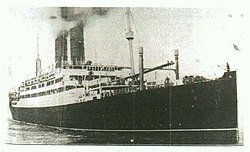Tuscania (ship, 1915)
|
||||||||||||||||||||
|
||||||||||||||||||||
|
||||||||||||||||||||
|
||||||||||||||||||||
|
||||||||||||||||||||
The Tuscania (I) was a passenger ship put into service in 1915 by the British shipping company Anchor Line . From 1916 served Tuscania in the First World War as a troop carrier until it by a German on February 5, 1918 submarine sunk was.
The ship
The 14,348 GRT steamship Tuscania was built in the Linthouse district of Glasgow at the Alexander Stephen and Sons shipyard. The ship was launched on September 4, 1914 with hull number 459 and was completed in February 1915. The hull was 167.4 meters long, 20.3 meters wide and had a side height of 12.7 meters. On board there was space for 271 passengers in the first, 246 in the second and 1900 in the third class. The steamer was equipped with a writing room, a smoking room, a lounge, a fitness room and a veranda café.
The Tuscania was built for the New York - Glasgow route. Her sister ship was the Transylvania , which was completed shortly after her, but was only used briefly as a passenger ship because of the outbreak of war. She and the Transylvania were the largest ships in their shipping line. On February 6, 1915, the Tuscania ran with 393 passengers on her maiden voyage to New York, where she arrived on February 16. On February 20, 1915, she cast off to return to Glasgow. The Tuscania made international headlines after taking passengers and crew of the Greek ocean liner Athinai on September 20, 1915 under the command of Captain Peter McLean , which went up in flames on September 19 in the middle of the ocean.
In September 1916, the Tuscania was taken over by the British Admiralty and used as a troop transport to bring Canadian troops from Halifax to Liverpool . In August 1917 she brought 1,236 men of the 16th US Engineer Regiment from New York to Liverpool. On January 24, 1918, she and 384 crew members and 2013 US soldiers left Hoboken (New Jersey) for Le Havre and joined the HX-20 convoy from Halifax .
Sinking
On Tuesday, February 5, 1918, on a journey from New York to Liverpool, she was found seven nautical miles north of Rathlin Island on the coast of Northern Ireland at position 55 ° 37 ′ N , 6 ° 26 ′ W of UB 77 , a German underground Type UB III boat under the command of Kapitänleutnant Wilhelm Meyer attacked. On board were 2,235 people, including 113 officers, 1,917 members of the United States Army, as well as crew members, cargo, mail and passengers. Captain Peter McLean was in command again.
At 5:40 p.m. UB 77 shot down two torpedoes, one of which missed its target, but the other hit boiler room No. 1. By 7:00 p.m. all lifeboats were in the water, but most of the soldiers were still on board the ship. The Tuscania developed a strong list to starboard and sank at around 10:00 p.m. 166 people lost their lives as a result of the sinking. The survivors were brought ashore at Buncrana and Larne .
The Tuscania was the largest ship sunk by UB 77 . UB 77 attacked the 20,904 GRT Celtic of the White Star Line eleven nautical miles south of the Isle of Man on March 31, 1918 , but the ship did not sink. The Celtic was towed to Liverpool and repaired. The Tuscania was the first ship sunk by a German submarine in World War I that US troops had on board. The sinking made headlines and controversy in the United States .
Web links
- Technical and historical framework data of Tuscania
- The Tuscania in the Clydebuilt Ships Database
- The sinking of the Tuscania in the submarine database
- Tuscania, an American Story
- Detailed report on the history of the ship and its sinking (with pictures)
- Report of the maiden voyage in the New York Times on February 17, 1915
- Report of the sinking in the New York Times, February 7, 1918
- Report of the sinking in the New York Times, February 8, 1918
- Report of the sinking in the New York Times on February 9, 1918
